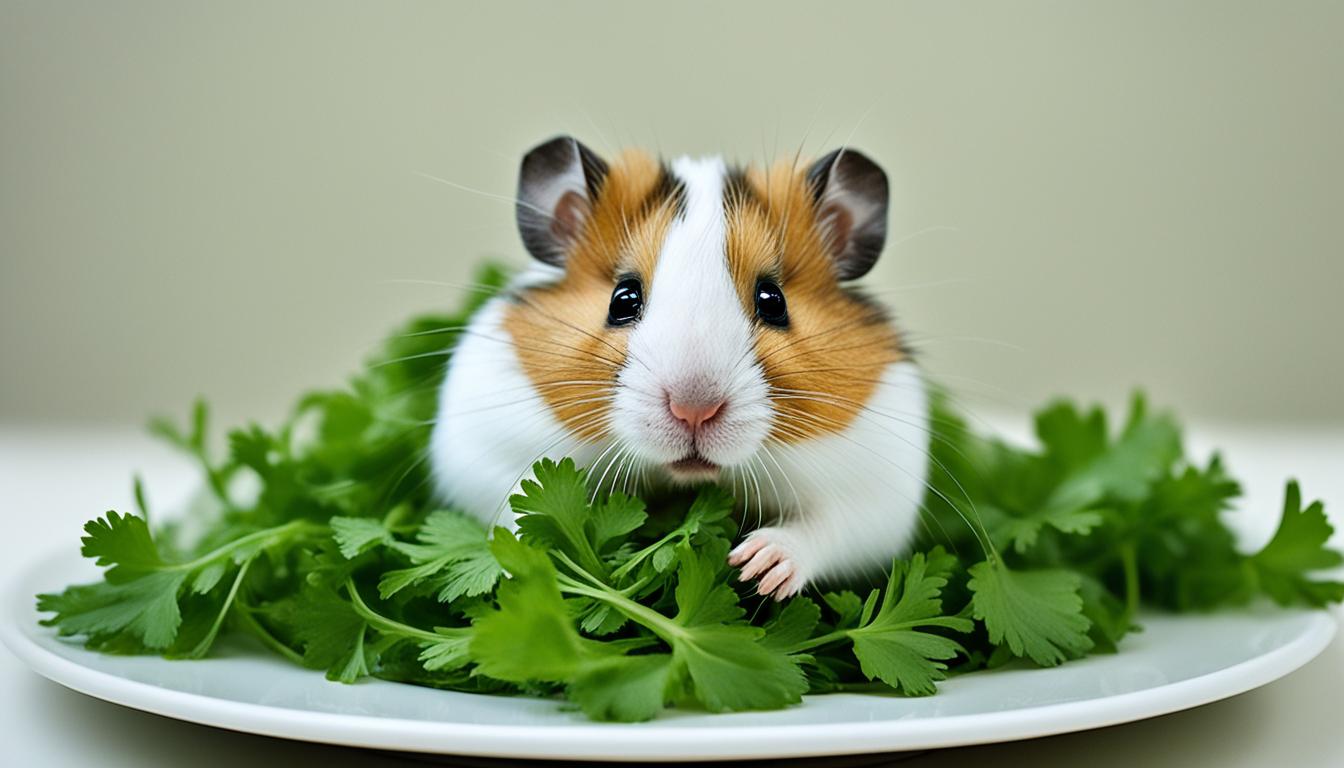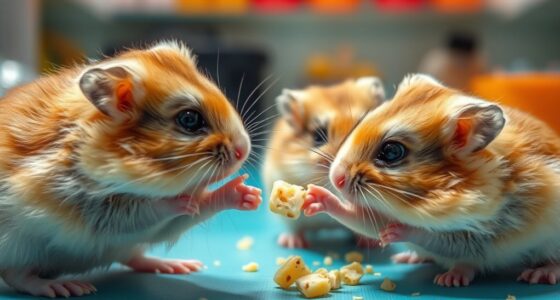Scientists recently discovered that hamsters love midnight marathons because their natural biology and circadian rhythms make them most active during the dark hours. As nocturnal creatures, they’re wired to explore, run, and socialize when it’s night, which keeps them safe and happy. Their lively nighttime antics are a healthy part of their instincts, not stress or boredom. If you keep watching, you’ll see how adorable and true to their nature their midnight adventures really are.
Key Takeaways
- Hamsters are naturally nocturnal, with peak activity during dark hours due to their evolved circadian rhythms.
- Their midnight marathons are a survival instinct to avoid predators and optimize foraging opportunities.
- Nighttime activity aligns with their internal biological clocks, triggering bursts of energy like running on wheels.
- Short sleep cycles during the day conserve energy, making their active nights lively and energetic.
- Understanding these natural behaviors explains why hamsters love their adorable midnight marathons.

Many hamster owners have noticed their pets suddenly racing on the wheel late at night, turning ordinary exercise into a miniature midnight marathon. This behavior isn’t random; it’s deeply rooted in their biological rhythms. Hamsters are nocturnal creatures, meaning they’re naturally active during the night and sleep during the day. Their sleep cycles are aligned with the dark hours, so when the sun sets, your hamster’s energy levels spike, prompting them to engage in vigorous activity. This pattern isn’t just a preference—it’s an essential part of their evolutionary makeup. In the wild, hamsters forage, explore, and socialize under the cover of darkness, avoiding predators and maximizing their chances of survival. Their nocturnal behavior is hardwired into their DNA, making daytime sleep and nighttime activity their default mode. Circadian rhythms play a crucial role in regulating these behavioral patterns, ensuring their activity aligns with their environment.
Understanding hamster sleep cycles helps explain their midnight marathons. During their active phases, they experience bursts of energy, which is why you often see them darting around on their wheel or exploring their environment late at night. Their sleep cycles are brief but frequent, meaning they don’t sleep for long stretches like humans do. Instead, they rest in short naps scattered throughout the day, conserving energy for their nighttime activities. When night falls, their bodies switch into high gear. Their internal clocks, known as circadian rhythms, signal that it’s time to be alert and active, leading to the energetic sprints on their wheel and frantic burrowing.
This nocturnal behavior is a survival strategy that has persisted through evolution. It keeps them safe from daytime predators and allows them to find food and mates during hours when other animals are less active. As a pet owner, you might notice your hamster’s lively nighttime routine, which is perfectly natural. It’s a sign that your hamster is fulfilling its biological needs, not a cause for concern. To support this behavior, create a quiet, dark environment during their sleep hours and provide plenty of stimulation for their active period. Understanding their sleep cycles helps you appreciate the adorable midnight marathons, knowing they’re a healthy expression of your pet’s natural instincts. In the end, their nocturnal tendencies make hamsters uniquely charming, turning your quiet nights into lively, adorable displays of their intrinsic nature.
Frequently Asked Questions
Do All Hamster Breeds Enjoy Midnight Marathons Equally?
Not all hamster breeds enjoy midnight marathons equally. Breed differences influence activity preferences, with some breeds being more energetic and active at night, while others prefer calmer routines. You might notice Syrian hamsters tend to be more active during their dark hours, whereas dwarf breeds can have varied activity levels. Understanding your hamster’s breed helps you tailor their environment, ensuring they get the right amount of exercise and stay happy and healthy.
Can Hamster Midnight Activity Affect Their Lifespan?
You might wonder if your hamster’s midnight activity impacts its lifespan. Disrupting their natural sleep patterns can affect nocturnal health, leading to stress or immune issues. While occasional late-night play isn’t harmful, frequent disturbances may shorten their lifespan. To keep your hamster healthy, make certain it has a quiet, dark environment during the day and a consistent schedule. Maintaining proper sleep patterns supports their overall well-being and longevity.
How Can Owners Safely Support Their Hamster’S Nighttime Energy?
You might be surprised to learn hamsters are naturally most active at night, so supporting their energy safely is key. You can do this by providing cage enrichment—like tunnels or wheels—that encourage activity without overexertion. Additionally, offering dietary supplements rich in vitamins helps maintain their health. Ensuring a quiet, comfortable environment allows your hamster’s nighttime energy to thrive safely, promoting a happier, healthier life for your tiny friend.
Do Hamsters Prefer Running Alone or in Groups During Marathons?
You might wonder whether hamsters prefer running alone or in groups during marathons. While some hamsters enjoy social interaction, many prefer the solitude to avoid stress from social isolation. Group dynamics can be complex; if introduced properly, they can run together comfortably. However, always monitor their behavior to verify they’re not overwhelmed, and provide options for solo or group play, depending on your hamster’s personality and comfort level.
Are There Specific Scents or Sounds That Encourage Hamster Midnight Activity?
Like a symphony of sensory stimulation, certain scents and sounds can boost your hamster’s midnight activity. Soft background noises, like gentle rustling or calming music, act as environmental cues that excite them. Aromas such as dried herbs or fruit scents can also trigger their natural instincts to explore and run. By creating these sensory cues, you encourage your hamster to stay active and engaged during its nighttime adventures.
Conclusion
Now you see, those tiny hamsters aren’t just running in circles—they’re chasing something special. Their midnight marathons aren’t just adorable; they’re a window into their world, where energy and curiosity collide under the moonlight. So next time you see a hamster dart across the cage at night, remember, they’re burning the midnight oil, proving that even the smallest creatures have big dreams and boundless zest for life. It’s a reminder that sometimes, the night holds the brightest surprises.










